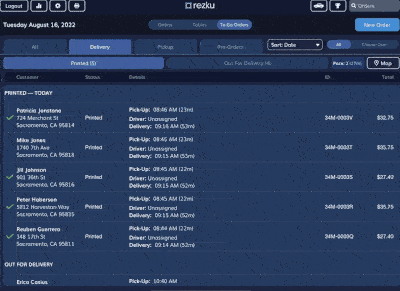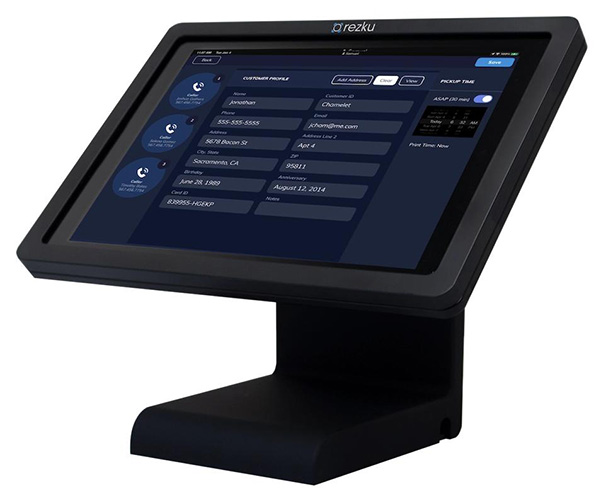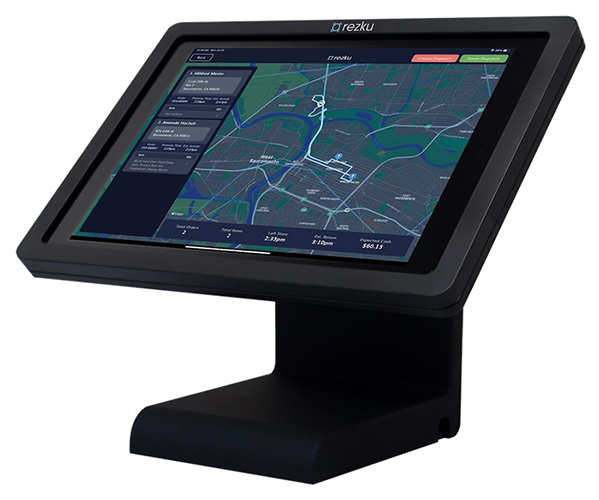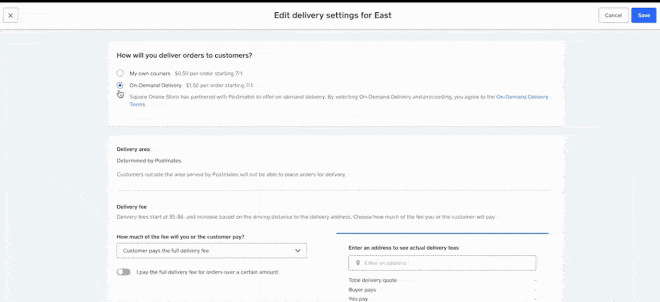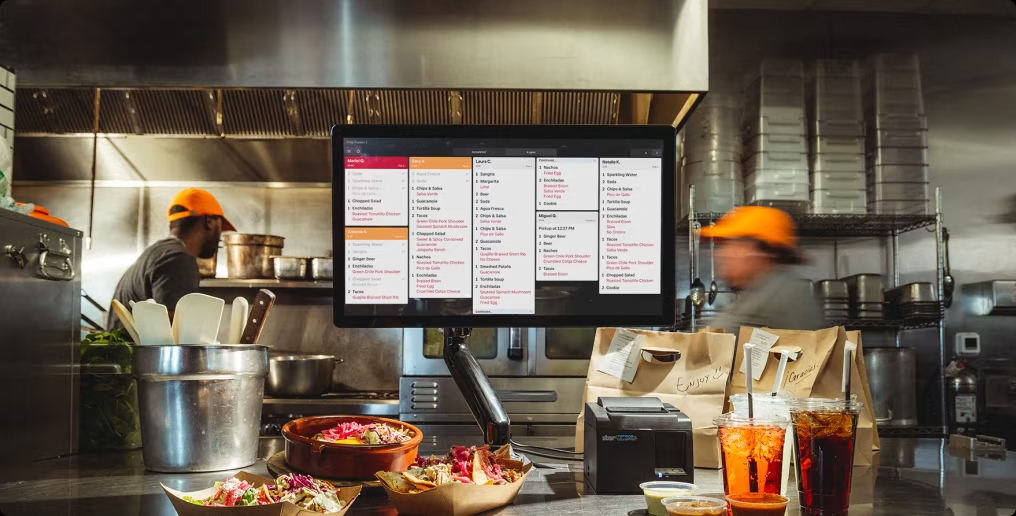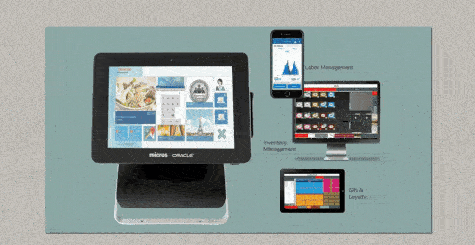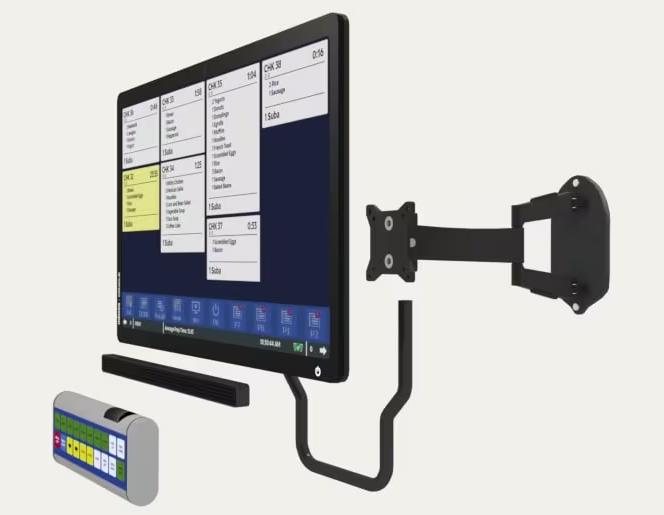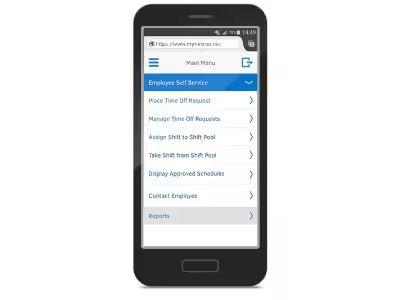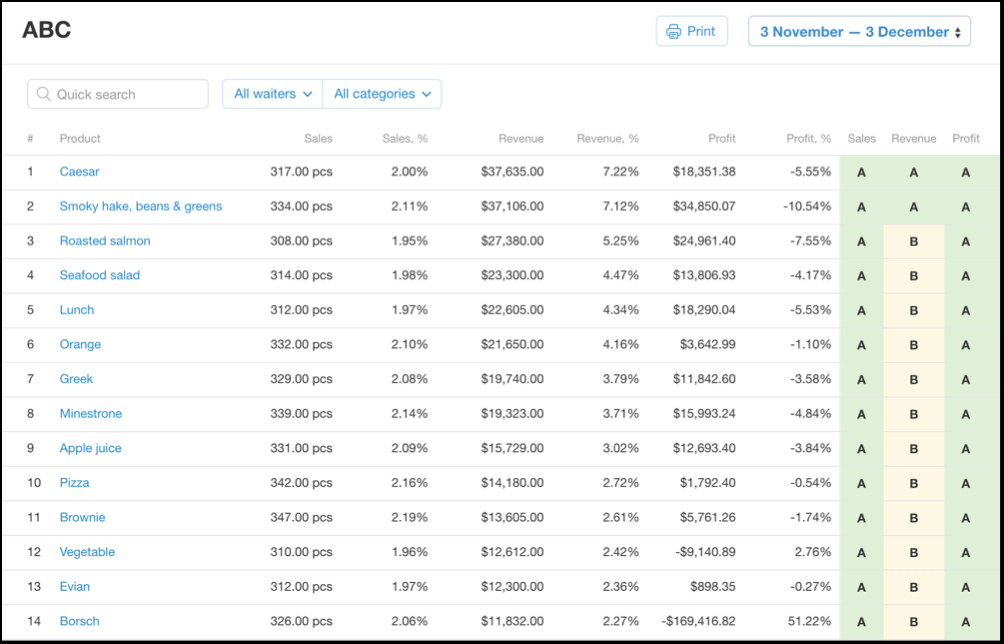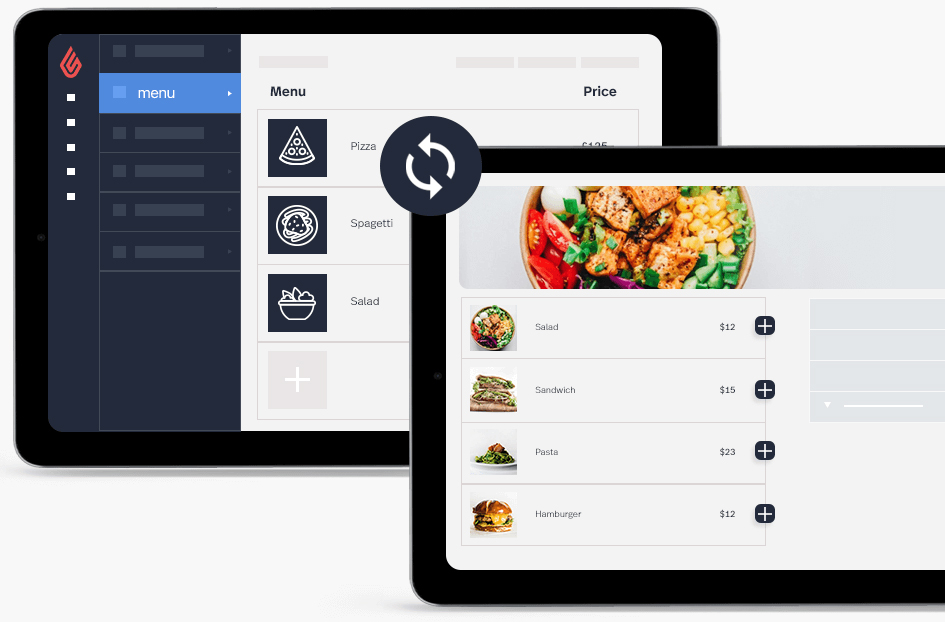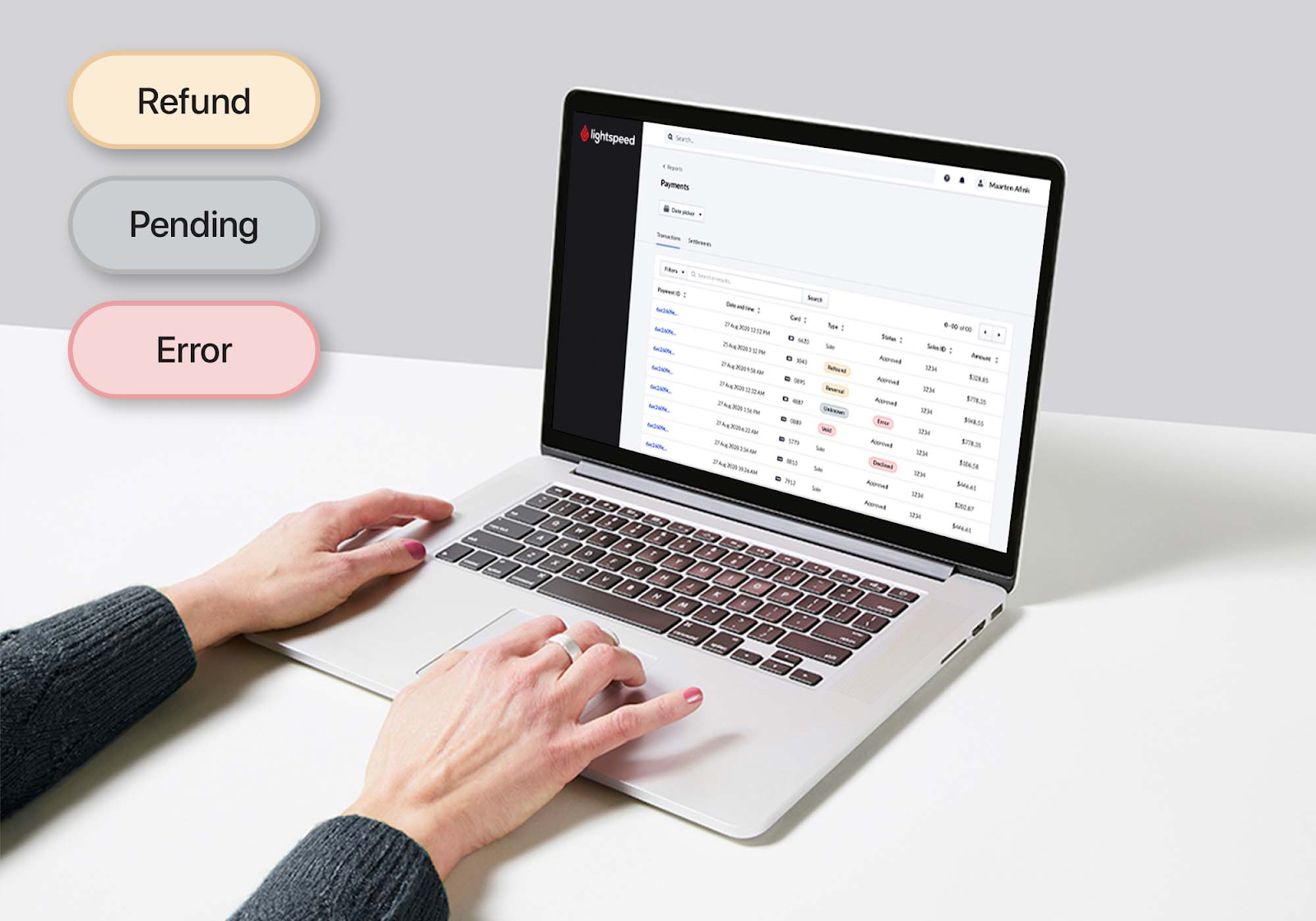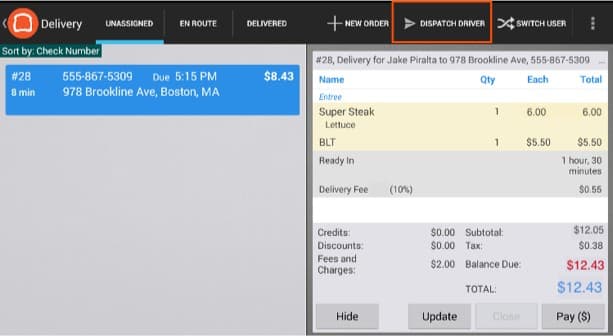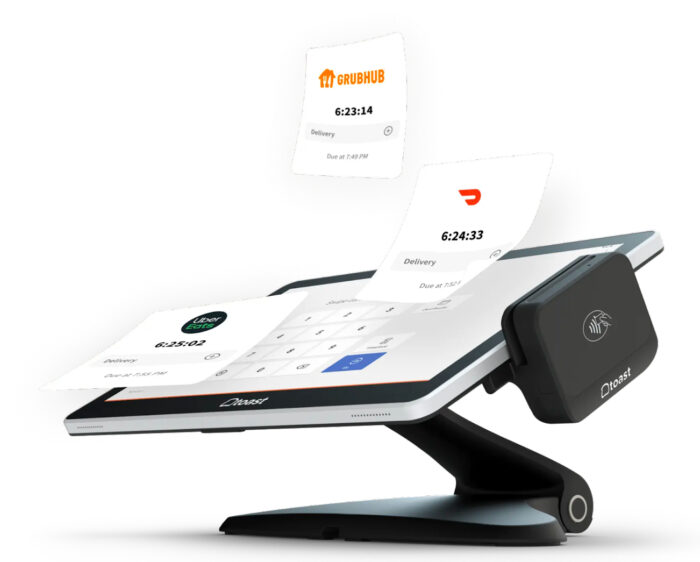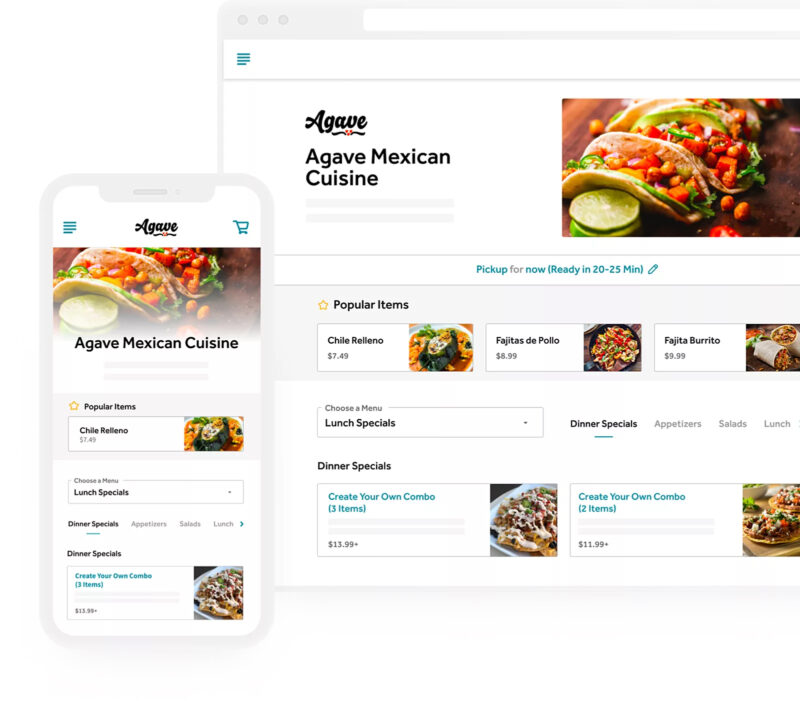Ghost kitchens (also called cloud kitchens or dark kitchens) differ from traditional restaurants in that they prepare food for takeout and delivery only. They take online or phone orders and most often work with one or more third-party delivery services. With a ghost kitchen, you can execute on multiple different brands in the same physical location, offering more revenue-building opportunities for your business.
While some delivery services like DoorDash provide an iPad for managing orders, ghost kitchens can benefit from a point-of-sale (POS) system that coordinates all orders, tracks ingredients, and manages drivers so you can concentrate on creating great food on schedule. The best systems allow ease of use and transparency for both diners and operators.
We considered over a dozen POS systems to choose the six best for ghost kitchens. The best cloud kitchen POS systems are:
- Rezku: Best overall POS for ghost kitchens
- Square for Restaurants Plus: Best free-to-use cloud pos
- Oracle Simphony: Best for workforce management
- Poster: Best for new ghost kitchens or those that change menus frequently
- Lightspeed: Best for reporting and analytics
- Toast: Best for managing third-party delivery orders
Best Ghost Kitchen POS Systems Compared
POS System | Monthly Fees* | Online Transaction Fees | Third-party Delivery Integrations | Contract | Driver Management |
|---|---|---|---|---|---|
$0–$199 | 1.99% + 25 cents | 100+ | 2 years | Excellent | |
$0–$60 | 2.9% + 30 cents | 10+ | None | Good, but lacks driver maps | |
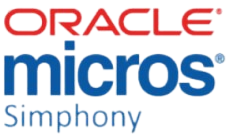 | $55–$75 | Varies by processor | 2+ | 1 year | Good, includes customer time estimates |
 | $29–$69 | Varies by processor | ViaGetOrder | None or 1 year | Excellent |
 | $69–$399 | 2.6% + 10 cents | 4+ | None | N/A |
 | $0–$165 | 2.99% + 15 cents | 12+ | None | Excellent |
*Based on month-to-month rates
Rezku: Best Overall POS for Ghost Kitchens

Pros
- Driver route optimization tools
- Baseline POS includes online ordering, loyalty, and gift cards
- Pace or throttle orders easily, and auto 86 items included
- Branded online ordering app available for customers
Cons
- Limited to 2 terminals on plan
- Limited to Rezku payment processing
- 2-year contract
What We Like
Rezku offers excellent tools for ghost kitchens, a cash rewards program (that can save you processing fees), loyalty programs and gift cards, and free POS software that contains everything from online ordering to gift cards and KDS software. The driver management tools are first-rate, not only with maps but also with route optimization. So, if you are OK with a contract, Rezku is a great choice. The processing rates are also very competitive and affordable. Beyond this, you have access to hundreds of third-party integrations to ensure you have all the tools you need to successfully operate your ghost kitchen.
It earned 4.56 out of 5 on our rubric. We found it easy to use with a lot of great features, including easy onboarding and employee management, remote smartphone system management, and unlimited data backups. However, requiring a two-year contract and being limited to only its in-house payment processing cost it points. If you need an API (for integrating a delivery service not on its list) or handle multiple locations, you will need the Enterprise Plan.
Monthly Software Fee
- Startup: $0
- Growth: $99
- Established: $199
- Enterprise: Custom quote
Processing Fees
- Startup: 1.99% + 25 cents
- Growth: Tailored to operation
- Established: Tailored to operation
- Enterprise: Custom quote
- Online Ordering Included: Like Square, Rezku includes online ordering even in its most basic system. You’ll get a custom-branded menu website and can create a QR code for it, which is a great tool for marketing. Online orders will sync with your inventory and your KDS. If you 86 an item on the menu, the online menu is also updated. Add-ons such as a custom app for your restaurant, multi-location management, and text-ready notifications are also available as add-ons.
- Order Pacing: Order pacing, a feature Rezku shares with others on its list, is based on 15-minute slots; orders over the limit you set automatically bump to the next slot. This gives better pickup and delivery estimates for customers. You can set this temporarily to throttle orders or to keep a specific pace permanently. You can additionally auto-86 items you are sold out of, avoiding customer disappointment when you run out of menu items during busy business periods.
- Delivery Management: We were impressed by Rezku’s delivery management tools. While many, like Toast, have GPS tracking, Rezku will also optimize routes so your drivers can do multiple deliveries at the best times. Like Toast, Rezku also works with DoorDash Drive, allowing you to route deliveries to DoorDash drivers. The DoorDash Drive integration is $39/month as an add-on.
- Dispatch Management Center: Rezku lets you manage all of your deliveries on a single screen through its Dispatch Management Center. You can see delivery times, payment statuses, and customer satisfaction all through this one dashboard. The service goes even deeper with cash owed, estimated driver return times, and individual driver history that allows you to manage drivers on a micro level.
- Labor Management Tools: Rezku offers an incredibly intuitive labor management dashboard, which updates you on your real-time labor cost against the sales you have brought in. In addition, you can see employees on shift and when they clock in and out. This dashboard also allows you to make payroll reports and any working time corrections that may need to be done. Finally, you can add or remove employees to your system through this tool.
Square for Restaurants: Best Free-to-Use Cloud POS

Pros
- Easy setup
- Includes delivery management tools, online ordering website
- Square Shifts (scheduling) included
- In-depth reporting
Cons
- Onboarding training has fee attached
- Tied to Square Payment Processing
- No options for industry-grade hardware
What We Like
Square often ranks high among our best-of lists for POS systems and payment processing. It offers a free basic version that includes online ordering—you only pay for credit card processing. However, in this case, we recommend Square for Restaurants Plus (at $60 per month), which also includes advanced inventory, scheduling, and the KDS software. This tier also allows you to open closed checks and an unlimited number of team members to be scheduled with Square Shifts. Plus, as you grow, Square grows with you with features like payroll, banking, and scheduling.
It earned an excellent 4.41 out of 5 on our rubric. The only thing keeping it from maxing the pricing score was that it only offers Square payment processing. Also, one-on-one training starts at $1,399, which is incredibly expensive for those wanting in-depth training on their POS system. Besides that, Square for Restaurants Plus is great for any cloud kitchen operator in need of reliable POS software.
Monthly Software Fee
- Free: $0
- Restaurant Plus: $60
- Premium: Custom quote
Processing Fees
- 2.9% + 30 cents
- Custom rates available for over $250,000 in monthly processing
- Set Up Multiple Online Menus: Why limit yourself to one concept? Square lets you launch as many online ordering pages as you need, so your ghost kitchen can provide anything from sushi to Southern homestyle cooking. This feature is great for restaurants working with different restaurant brands to bring more revenue into the business. Square funnels these different concepts back to your KDS in an organized manner, allowing you to fill different brand orders with accuracy.
- Auto86 Reflects Across Menus: Square’s automated inventory counts will automatically 86 an item across all internal menus (you’ll still need to update third-party menus yourself or via a middleman app). Toast, Rezku, and Lightspeed also have this feature. You need to take off or snooze an item manually with the others. This becomes helpful when you are managing multiple concepts and need a quick and efficient way to be organized within them.
- Flexible Delivery: Square integrates directly with third-party platforms Slice, Postmates, and DoorDash. If you prefer aggregating apps, you can choose from several, including Deliverect and Chowly. Like Toast, Square allows you to hail third-party drivers on-demand for flat rate fees or deliver via an in-house team. Square charges a fee of 50 cents for each delivery processed by your in-house team, so you can pay as you go. Others on our list require flat monthly fees no matter how many deliveries you process. However, Square’s driver management system does not include maps. Rezku offers the best route optimization tools for drivers.
- Square Team Management: Square’s Team Management service, available in the Restaurant Plus plan, allows you to track labor and tips and even gives the option to offer your employees benefits. You can also track prep times, have tickets auto-print based on timing through each kitchen station, and have dedicated and customizable naming on menu items and categories for your staff to follow along to.
- In-depth Online Ordering Tools: Square has built out a truly efficient and easy service for those ordering online. It has features such as the ability for customers to reorder past orders in just three taps, allow as many ordering screens as you would like, and accept different online payments such as Apple Pay and Cash App. Square’s online ecosystem is built to help improve online ordering, which is why it caters so well to the cloud kitchen concept.
Oracle Simphony: Best for Workforce Management

Pros
- Built-in onboarding, scheduling, training
- Industry-grade hardware withstands high-volume use
- Built-in loyalty program
- Location-aware technology for pickup orders
Cons
- Hardware is custom-quoted
- 1-year contract required
- Most integrations require an API
What We Like
Oracle Simphony is a hardy POS system for restaurants, and with the GloriaFood app (also by Oracle), you can manage your online orders from mobile, website, or third-party delivery sources. Simphony stands out, however, for its workplace tools. Included in all plans are scheduling, onboarding, training, and time off management tools. Additionally, its KDS works by collecting data from all points of customer and employee contact, allowing for information to be seamlessly relayed to the kitchen staff.
This POS earned 4.13 out of 5 on our rubric. It missed out on points for not offering a free plan and earned excellent scores for its backend tools and online training. The included workforce tools and loyalty program were definite points in its favor. Plus, at $55 for the most basic program, it’s nicely priced and gives you a choice of payment processors so you can get the best deal. On top of that, it offers cloud-based reporting, which allows you to dig into all of your data, no matter how many different brands or sales channels.
Monthly Software Fee
- Essentials: $55
- Plus: $75
- Single Tenant: Custom quote
Processing Fees
Processing fees vary by the payment processor you choose to use and integrate with Oracle
- Hardware Designed to Withstand Kitchen Environments: Like Toast, Oracle Simphony operates on industry-grade hardware designed for humid, hot, and dusty conditions. Many on our list, like Square, mostly employ standard iPads. The new Oracle MICROS Workstation Series 8 allows for many configurations of the software depending on customer needs. Simphony advertises its terminals for as little as $1 each, but you need to contact Oracle for a precise quote, as conditions may apply.
- Workforce Management: Simphony offers excellent tools for managing your employees. The HR module lets you onboard employees with contact and other information that applies to scheduling—such as notifying you if you overschedule a minor. It tracks time and PTO for accurate payroll. Even more, employees can use the self-serve app to manage schedules and request time off. It doesn’t just let you create schedules; its forecasting tools can make recommendations for schedule optimization.
- Inventory Management: A large reason to invest in workforce management is to ensure that inventory and your goods are handled properly. Oracle Simphony’s inventory forecasting tool helps you understand and expect where par levels should be. Oracle also tracks inventory discrepancies and offers menu modeling to see how costs and price changes will affect menu items before making these changes. This is huge when wanting to figure out the best price to sell a menu item at.
- Intuitive Kitchen Display: Oracle’s KDS technology allows for extremely efficient information relay between staff members and the back of the house. The KDSes themselves are built with touch screens and bump bars and are also designed to handle the heat they will be exposed to in a live kitchen. They do require a custom quote but are made for ease of use and durability in any professional kitchen. Oracle updates your KDS screen the second an order comes in, offering and touting speed and durability in both their software and hardware for kitchen functions.
- Support for Non-US Businesses: While others on our list may work with a few other countries, Oracle supports over 180 countries.
- Customer Updates: Like the other ghost kitchen POS systems on our list, you can let customers know when an order is out for delivery. Oracle Simphony goes one step further, however, by tracking driver locations to give customers live updates. This can improve customer experience while also offering more precise details for both you and your customers.
Poster: Best for New Ghost Kitchens or Those That Change Menus Frequently

Pros
- Cheapest plan includes delivery management (+$19/month add-on for website that accepts payments for orders)
- Kitchen Kit/KDS includes recipe management
- Driver app includes maps
- Intuitive and easy menu management
Cons
- KDS requires highest-priced plan
- Limits on products and dishes
- Delivery integrations through API or middleman app
What We Like
Poster is the only POS system on our list that includes access to recipes in its kitchen display system. This, along with price, makes it a great choice for new cloud kitchens, but it’s also a good choice if you have high staff turnover or like to change up your menu often. Menus can include pictures of food, color coordination, and more to help staff new to your operation. It also offers a strong app for drivers, which lets you track and monitor statistics and performance for each individual courier that comes into contact with your business.
This POS earned a respectable 4.09 out of 5 on our rubric. It would have earned a much higher score if it had had scheduling tools, an online ordering website (you can get an integration for this), and the ability to easily update menus as you run out of items. However, it got top marks for training and setup, customer support, reporting, and loyalty. Real-world user reviews on Capterra give it an astounding 4.8 out of 5 across 69 verified user reviews.
Monthly Software Fee
- Mini: $29; $24 with yearly contract
- Business: $49; $44 with yearly contract
- Pro: $69; $64 with yearly contract
*$19 monthly for a website that will accept payments as well
Processing Fees
Processing fees vary by the payment processor you choose to use and integrate with Poster
- Kitchen Kit: Like the others on our list, Poster can send orders to a kitchen display system—like Square, this is a tablet rather than an industry-grade KDS. (Consider Toast and Oracle Simphony for the best hardware.) What sets it apart from the others, however, is that the orders can include the recipe and cooking instructions. This feature allows you to not only train staff with ease but also allows ease of development of staff and overall order accuracy, no matter how many recipes you offer.
- Delivery Tracking: Once an order is ready, a message is sent to the cashier’s terminal. You can then assign a driver. Like Square, you can create special offers and cash-back options for delivery services. The Poster Courier mobile app lets you notify your delivery drivers through the app and provides maps for delivery locations. However, it does not do route optimization like Rezku. What it will do, though is send you individual statistics for each courier, allowing you to monitor and adjust as needed.
- Marketing: Unlike Square, Poster includes a loyalty feature in all its plans. You can offer different discounts or bonuses, such as those based on points. It works via SMS rather than cards, so customers can activate rewards with just their phone number. You can also integrate applications such as chatbots if desired.
- Works on Many Devices: Another advantage for a kitchen just starting out is that Poster works on Android tablets or iPads rather than proprietary hardware like Toast or Simphony. This allows all necessary stakeholders within your operation to access the data they need, regardless of their phone’s operating system.
- Flexible Pricing: Pay attention to the pricing tiers on Poster, as you may be able to find a deal. While each plan has a suggested use case (coffee shop, bar, etc.), the pricing tier goes by the number of menu items you offer. While you may be a “restaurant,” if you have a limited menu then a lower-priced tier will work with you while saving you money. Know your menu item count before committing to a plan, and you could actually really save on your annual or monthly subscription.
Lightspeed: Best for Reporting & Analytics

Pros
- Automated reports provide a ton of customer, staff, and menu insights
- Streamlined third-party delivery integrations
- Easy self-install; operates on iPads
- Online ordering tools allow for consistent communication with repeat customers to your business
Cons
- Driver management not available
- Online ordering only available at $189 tier
- API in highest plan only
What We Like
Lightspeed is a powerful and popular restaurant POS system well known for its ease of use and excellent, ingredient-level inventory tracking. Lightspeed also offers robust automated reporting to give you the best insights into your business and what your customers are ordering. This, along with their ability to run on affordable iPads, makes Lightspeed a great choice for cloud kitchens with a lot of moving parts.
Earning 4.04 out of 5 on our list, it also ranked on our ghost kitchen POS list because of its excellent add-on for third-party delivery services. However, the add-on has additional costs, which kept Lightspeed from scoring higher. It also lost points because it lacks built-in driver management and workforce management tools, which is only truly an option with an add-on Nonetheless, Lightspeed is a solid system that’s easy to use and lets you bring your own your own compatible hardware.
Monthly Software Fee
- Starter: $69 (Does not include online ordering)
- Essential: $189 (Includes online ordering)
- Premium: $399 (Includes online ordering)
- Enterprise: Custom quote
Processing Fees
- 2.6% + 10 cents for the Starter and Essential Plans. Custom quote needed for higher tiers.
- Lightspeed Delivery: Lightspeed Delivery is a premium add-on to the Lightspeed Restaurant POS with a custom quote. Pricing for this add-on averages $50–$120 a month. This module consolidates online orders from third-party services like Uber Eats, Skip the Dishes, and DoorDash. It also lets you manage your menus across all third-party delivery sites in one location. Additionally, this feature allows you to maximize your delivery zone to offer to the most customers possible.
- Promotions: Lightspeed Delivery also comes with excellent promotional tools that others charge extra for. You can create discounts on delivery prices or promotions to attract new or returning customers. Additionally, you can create promo codes to use with social media and advertising. Use its tools to share positive reviews to let others know how much people love your food.
- Auto86 Reflects Across Menus: With Lightspeed Delivery, you can update your menu across all platforms from a single dashboard; plus Lightspeed’s inventory tools allow auto86ing of items as they run out. This puts it on par with Toast, Rezku and Square. Advanced Inventory Management is only available in the $189 plan as well.
- In-depth Inventory Tools: Manage your in-house inventory within or across multiple locations with Lightspeed’s inventory tools. Track ingredient-level items, track waste, and look at overall purchasing data using its interface. You can also access monthly sales reports and export inventory reports when needed. Advanced Inventory Management is only available in the $189 plan as well.
- Automated Reporting: Lightspeed’s reporting module syncs with Lightspeed Payments to generate detailed customer profiles and reports. Even if the same customer has multiple delivery addresses or uses different cards to pay, your Lightspeed POS will link their data. So you get a deep look at purchase history and customer preferences without pulling a ton of reports. Lightspeed also includes detailed staff reporting and excellent menu reports.
Toast: Best for Managing Third-party Delivered Orders

Pros
- Robust driver management with GPS integration
- Industry-grade hardware can handle high-volume restaurant use
- Includes invoicing tools that are effective, but an extra cost
Cons
- Must purchase Toast-built hardware
- Online ordering is an add-on, or comes with the highest plans
- Tied to Toast payment processing
What We Like
Toast ranks No. 1 in our list of leading food delivery POS systems and places high in our list of best online ordering systems for small restaurants. Toast’s ability to aggregate your menu into different ordering platforms is what makes it so easy to use and get your business shown on third-party apps. It also has its own mobile food ordering app, Toast TakeOut. It’s a popular food ordering app highlighting Toast users and is a great way to get instant advertising.
Toast earned a 3.89 out of 5 on our list. Pricing was an issue since the online component requires a more expensive plan, and some of the components we looked for (like scheduling) also cost extra. Additionally, inventory tools and some workforce management tools were an extra cost, whereas other POS systems on this list include these key features in some way. However, if you do go with Toast, the quality of the product you will use is industry-leading, so be aware of this when making your decision.
Monthly Software Fee
- Quick Start Bundle: $0 (pay as you go)
- Core: $69
- Growth: $165
Processing Fees
- 2.99% + 15 cents
- Toast Aggregator: Toast offers its own app for hungry customers. Toast TakeOut & Delivery lists your restaurant and menu, so diners in your area can order food directly from you. This then feeds into your POS system like other delivery services. It has over 500,000 downloads with 4.9 out of 5 stars on Android and 4.7 out of 5 with over 66,000 ratings on iOS.
- Inventory by xtraCHEF: Toast offers inventory management through xtraCHEF. This system allows you to sync invoice information into your accounting system, track fluctuating costs, and track inventory with efficiency and ease. xtraCHEF excels at accounting-related invoice tasks and is a great asset for anyone running one or multiple brands out of their ghost kitchen. This is a great system, but is an add-on product that will be quoted by Toast.
- Delivery Services: If you have your own drivers, Toast lets you assign them routes, record tips, and schedule and manage them easily. It offers Google Maps and custom delivery areas and lets you program delivery fees. It also works with DoorDash Drive if you need to hail additional drivers for a flat rate fee (automatic $3.99 added on to each order but can be customized). The maps and DoorDashDrive options make it one of the best on our list; only Rezku with its route optimization does driver management better.
- KDS Syncs with Customers: Like the others on our list, online orders are coordinated and routed to your KDS or kitchen printer. Where Toast stands out, however, is that it automatically sends a text to customers when an order is completed by your kitchen team, a function also found in Simphony.
- Workforce Management: Unlike most on our list, Toast offers a complete workforce management system. You can onboard new employees through the system, storing their paperwork and prepping information for payroll. Plus, you can create schedules and control clock-in/clock-outs. However, like with Square, most of these features are add-ons that cost extra. (Simphony includes these in its system.)
How We Evaluated Cloud Kitchen POS
We considered the large selection of POS systems that we normally review and sought out lesser-known systems that specialize in cloud kitchen tools. Then, we narrowed it down for the best in terms of price, delivery options, online and contactless sales tools, and ease of use. We also took into consideration the input of real-world users via third-party review sites like Capterra.
Rezku ranked No. 1, with 4.56 out of 5. Its ability to manage both drivers, and workforce within a cloud kitchen and tools for growing a customer base consistently are what set it apart and make it the best for ghost kitchens, per our ranking.
Click through to see the scoring criteria:
20% of Overall Score
Here, we looked for month-to-month pricing and card processing fees that don’t eat all your profits. We took off points for extra charges for online ordering tools or use limits. Lightspeed earned a perfect 5 out of 5, with Square coming in second.
30% of Overall Score
Features refers to delivery tools like integrations, online menus, and delivery management. We also evaluated the kitchen display options (taking points off if it cost extra), and chargeback protection. Square earned 4.81 out of 5, making it the best in this category.
20% of Overall Score
Backend tools make running your ghost kitchen easier: inventory management, scheduling, marketing, reports, and the like. Oracle’s Simphony took the lead with 4.56 out of 5; several lost points because they only included these tools as add-ons or in their significantly more expensive plans.
15% of Overall Score
Onboarding, training, help tools, and customer service hours make up the bulk of this score, but we also considered the ease of 86-ing an item from all the menus of delivery systems you work with. Lightspeed won out in this category with 4.81 out of 5.
15% of Overall Score
Here, we rely on our years of experience with POS systems and the opinions of real-world users as posted on multiple third-party sites. Square had a perfect score, but Rezku came in a close second with 4.88 out of 5, losing points only because we found fewer than 50 user reviews.
Key Features to Look for in a Cloud Kitchen POS
The market for cloud kitchen POS systems is large and can be confusing at times. That is why we took the time to look at the market and see what the best systems have to offer. Below is a list of some of the key features you should consider when looking for a cloud kitchen POS system.
Pricing & Competitive Payment Processing
The first step in choosing a POS system is knowing the budget you can afford to spend on one and narrowing your search to that price point. There are many cost-effective and high-performing systems out there, and a lot of them are on this list! Be sure to consider price while also ensuring you get the features you need out of the system. Additionally, competitive payment processing is key so that you can make the most amount of money out of each customer purchase.
Driver & Delivery Management
Being able to manage your delivery methods, how you receive and organize your deliveries, and how you get your product to customers are all key to ensuring you run a successful ghost kitchen. Having tools that let you receive orders and relay them smoothly to your staff is the first major tool a solid system will have. Additionally, the ability to track delivery, let guests know expected delivery times, and monitor drivers is also paramount in being able to manage your cloud kitchen.
Website & Customer-facing Features
All of your planning will go to waste if your customers cannot access your food and order it easily. Having an easy-to-use customer interface that allows them to see your full menu and order with ease should be a key function you require in your POS system search. Ghost kitchens lack the intimacy of in-person dining, so having an ordering site and platform that welcomes and encourages guests to dine with you is paramount to your business’ success.
Quality Backend Tools
Workforce management can be a lifesaver, especially when you have a sizable staff to manage. Inventory tracking and live item updates to the menu are also key and will make your life a lot easier. Finally, a quality system of reporting back your business analytics will allow you to make key changes and pivots that increase the quality of your food service. Having helpful and insightful backend tools is key for any POS system.
Reputable POS Company
Finally, using a reputable and reliable POS company is something you should highly consider. Running into technical issues or having a system fail during busy order times is simply not an option. Doing research on the needs of your business and how the prospective system you choose addresses those needs is vital to ensuring the system you pick will work for your business. Read consumer reviews, ask for demos and trials, and read over our guide to pick the best cloud kitchen POS for your business.
Cloud Kitchen POS Frequently Asked Questions (FAQs)
These are the most common questions I hear about ghost kitchens, cloud kitchens, and their POS needs.
Ghost, dark, and cloud kitchens refer to the same thing, although “CloudKitchens” is also a service that provides kitchen space for rent along with the equipment for managing orders. Dark kitchens are usually small, mobile, self-contained spaces (sort of like a semi-permanent food truck) filled with kitchen appliances and accessories that connect to electrical and water, but they serve the same purpose.
Cloud kitchens work for delivery or takeout only (usually just delivery). Thus, there’s no overhead associated with on-location eating, like floorspace, waitstaff, or public restrooms. This can also be convenient when working as a larger company that franchises its brand. You have more real estate options to choose from, making expansion through mobile dining a positive for your business when done thoughtfully.
According to a study published in ResearchGate, the average profit for a restaurant runs from 3%–5%, while cloud kitchens usually enjoy a profit margin of 10%–12%. Cloud kitchens also have lower startup costs. That being said, ensuring proper systems that work for your restaurant and good marketing that gets your brand out there are key in order to make this profit margin a reality.
In all honesty, it depends on your business model. Delivery services like DoorDash give you a system for tracking orders. Thus, if you are using only a single delivery service or working with a franchise like CloudKitchens, they supply all the equipment you need. (Cloud kitchens will coordinate all the delivery services they use for you.)
However, if you take your own orders and orders from multiple delivery sites, a POS system will help you coordinate orders, track inventory, prompt for re-orders when supplies are low, and give you internal reports that you can use to audit your accounts with third-party platforms. A POS will also help you track staff hours and ease your payroll processes.
In addition to the items you need to create and pack the meals for delivery, you need a payment processing service, an online store, and a kitchen display system or kitchen printer for keeping track of orders. Most of these tools are provided by the POS system you select or the delivery service you work with.
There are two types of third-party platforms that send online orders to POS systems. Direct ordering and delivery platforms are third-party services that provide orders, drivers, and hardware, while middleman apps aggregate orders from multiple direct ordering and delivery platforms and send them to your POS.
Direct integrations with third-party platforms are better because you only pay per order processed. With the middleman apps, you still have to pay the third-party fees, but you also have to pay a monthly subscription fee (which can be pretty expensive).
Bottom Line
The market for takeout and delivery food has grown in popularity, and as a result, so have ghost kitchens. Removing the expense of a dining room with its staff, overhead, and upkeep means a greater profit margin. However, working with multiple delivery systems can get complicated. A good cloud kitchen POS software can help coordinate orders, while the best offer you your own online menu and delivery system.
We found that Rezku is the best ghost kitchen POS software. Rezku offers a free-to-use POS platform with extensive driver control and route optimizations. Customer loyalty programs, detailed KDS expansions, and competitive processing rates are also positives that allow for a system that any ghost kitchen operator can succeed with. Finally, having the ability to integrate with an endless amount of third-party tools allows you to spec out your ghost kitchen POS ecosystem to get the most efficiency and create great products.
